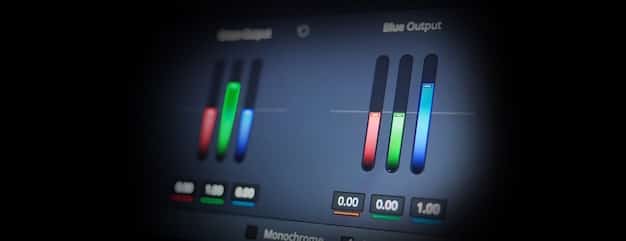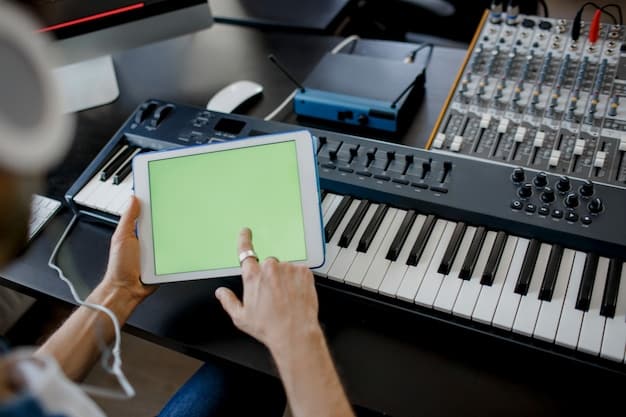Music Distribution for Emerging Artists: Choosing the Right Platform

Emerging artists navigating the music industry can leverage music distribution platforms to share their work globally, but selecting the right platform hinges on understanding its features, pricing, reach, and artist support.
For emerging artists: understanding music distribution platforms – choose the right one for you can be a game-changer. But with a plethora of online options, how do you select the best one to launch your music career?
Understanding Music Distribution Platforms
Music distribution platforms are essential tools for artists seeking to get their music heard worldwide. These platforms act as intermediaries, taking your music and making it available on various digital service providers (DSPs) like Spotify, Apple Music, Amazon Music, and more.
Choosing the right platform is crucial, impacting everything from royalty collection to how your music is presented to the world.

What Do Music Distribution Platforms Do?
These platforms handle the complex process of delivering your music to various digital stores. They also ensure proper licensing and payment of royalties, enabling artists to earn money from their streams and downloads.
Key Features to Look For
- Reach: The number of DSPs the platform distributes to.
- Royalties: The percentage of royalties the artist retains.
- Pricing: The platform’s fee structure (subscription, per-release, or commission-based).
Music distribution platforms play a crucial role in making your music accessible to a wider audience.
Major Players in Music Distribution
Several major players dominate the music distribution landscape, each offering a slightly different approach to getting your music out there. Understanding their strengths and weaknesses is vital for emerging artists.
Let’s explore some of the top platforms and what makes them unique.
DistroKid
Known for its unlimited uploads at a fixed annual price, DistroKid is a popular choice for prolific artists. It offers a range of features, including split payments and YouTube Content ID registration.
TuneCore
TuneCore charges per release and offers a range of services, including publishing administration and promotional tools. It’s a solid option for artists who prefer a pay-as-you-go model.
CD Baby
CD Baby is a long-standing distributor that provides both digital distribution and physical product sales. They also offer sync licensing opportunities and publishing administration.

Each platform offers a unique set of features and pricing structures to cater to different artist needs.
Understanding Royalty Splits and Payments
One of the most critical aspects of choosing a music distribution platform is understanding how royalties are split and paid out. This can significantly impact your earnings as an emerging artist.
Let’s delve into the details of royalty collection and disbursement.
How Royalties are Collected
When your music is streamed or downloaded, the DSPs generate royalties. These royalties are then collected by your chosen distribution platform, which processes them before paying you out.
Different Royalty Split Models
Platforms offer different royalty splits, which can range from 100% retention to taking a commission. Understanding these models is crucial for maximizing your earnings.
- 100% Retention: You keep all the royalties, minus any fees charged by the platform.
- Commission-Based: The platform takes a percentage of your royalties.
- Hybrid Models: A combination of fixed fees and commission.
Navigating royalty splits and payment options is key to ensuring fair compensation for your work.
Hidden Costs and Fees to Watch Out For
While many music distribution platforms advertise low prices, it’s essential to be aware of potential hidden costs and fees. These can eat into your earnings and affect your overall profitability.
Let’s uncover some of these hidden charges and how to avoid them.
UPC and ISRC Codes
Some platforms charge extra for providing UPC (Universal Product Code) and ISRC (International Standard Recording Code) codes, which are necessary for identifying your music.
Store Opt-Out Fees
Be wary of platforms that charge fees for removing your music from specific stores or for taking down entire releases.
Additional Services
While add-on services like publishing administration and sync licensing can be valuable, they often come with additional costs. Assess whether these services are truly necessary for your needs.
Being mindful of hidden costs and fees can help you make informed decisions and maximize your revenue.
Marketing and Promotion Tools Offered by Platforms
Beyond distribution, many platforms offer marketing and promotion tools to help artists reach a wider audience. These tools can be invaluable for emerging artists trying to build their fanbase.
Here’s a look at some of the marketing and promotional resources available.
Social Media Integration
Platforms often integrate with social media, allowing you to easily share your music and updates with your followers and connect with your fans.
Playlist Pitching
Some platforms offer playlist pitching services, where they submit your music to popular playlists. Getting placed on a playlist can significantly boost your streams and visibility.
Analytics and Reporting
Robust analytics and reporting tools allow you to track your performance, understand your audience, and refine your marketing strategies and track fans.
Leveraging marketing and promotion tools can help you amplify your reach and grow your audience.
Protecting Your Music Copyright
Copyright is a crucial aspect of being a musician, and understanding how to protect your work is essential. Music distribution platforms play a role in helping artists safeguard their intellectual property.
Let’s explore the basics of music copyright and how distribution platforms can help.
Copyright Registration
Copyright protects your original musical work and prevents others from copying or distributing it without your permission. You can register your copyright through the U.S. Copyright Office.
- Content ID: This system scans YouTube for unauthorized uses of your music and allows you to monetize those uses.
- Copyright Alerts: Some platforms notify you if they detect potential copyright infringements.
- Licensing Opportunities: Some platforms can help you license your music for film, TV, and other media.
Protecting your music copyright is vital for securing your creative and financial rights. By using the correct distribution platform you ensure your music can not be fraudulently, improperly used.
| Key Aspect | Brief Description |
|---|---|
| 🎵 Royalty Splits | Understand the percentage you keep versus what the platform takes. |
| 💰 Pricing Models | Consider subscription, per-release, and commission-based options. |
| 📢 Marketing Tools | Look for playlist pitching, social media integration, and analytics. |
| 🛡️ Copyright Protection | Ensure the platform helps protect your music from unauthorized use. |
Frequently Asked Questions
A music distribution platform is a service that helps artists get their music onto digital music stores like Spotify, Apple Music, and Amazon Music, worldwide.
Royalty splits refer to how the money earned from your music streams and downloads is divided between you and the distribution platform. Some platforms offer 100% retention. others commission based.
UPC (Universal Product Code) and ISRC (International Standard Recording Code) codes are unique identifiers for albums and tracks, helping stores to track sales and streams; these usually are provided by the platform.
Yes, you can switch platforms, but it involves taking down your music from the old distributor and re-uploading it onto the new one. It’s best to do research before choosing a provider.
Marketing support is very valuable, especially for emerging artists. Look for platforms that offer playlist pitching, social media integration, and detailed analytics to boost your visibility and fan tracking.
Conclusion
Choosing the right music distribution platform is a vital step for any emerging artist. By understanding the various options, royalty splits, hidden costs, and marketing tools available, you can make an informed decision that supports your musical journey and helps you reach new audiences. Remember to prioritize platforms that align with your goals and budget, ensuring you get the most out of your music distribution efforts.





